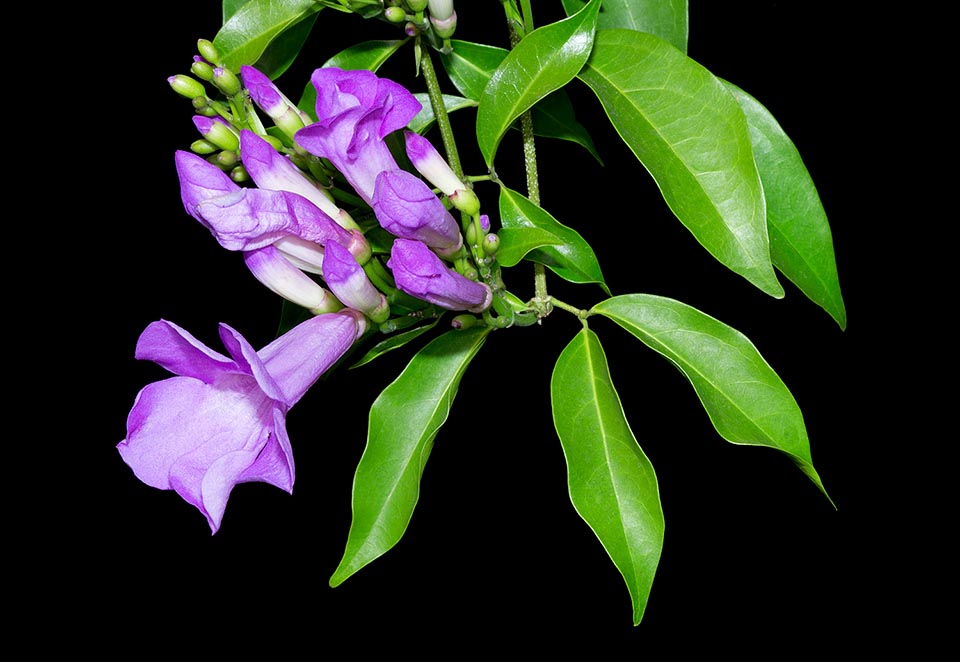Family : Bignoniaceae

Text © Pietro Puccio

English translation by Mario Beltramini
The species is native to tropical America (Bolivia, Colombia, Costa Rica, Ecuador, French Guyana, Guyana, Northern Brazil, Northern Leeward Islands, Peru, Southern Windward Islands, Surinam, Trinidad and Tobago) where it lives in the humid forests, often near water streams, from the sea level up to about 1000 m of altitude.
The genus is honored to the Brazilian physician and botanist Antonio Luiz Patricio da Silva Manso (1788-1848), the specific name is the Latin adjective “alliaceus, a, um” = similar to the garlic, with reference to odor of garlic emitted by the leaves when rubbed.
Common names: amethyst vine, garlic vine (English); alho-de-mata, cipó-alho (Brazil); campana morada, chica, chirriador (Colombia): jalapa (Costa Rica); liane d’ail (French); ajo del monte, ajo sacha, sacha ajo (Peru); bejico de ajo, mata de ajo (Puerto Rico).
The Mansoa alliacea (Lam.) A.H.Gentry (1979 pubbl. 1980) is a shrub or evergreen semi-woody creeper with 2-3 m long stems and young branches with almost quadrangular section. The leaves, on a 0,7-1,5 cm long petiole, are opposite, bifoliate, often with a simple 5-20 cm long tendril between the leaflets. Leaflets on a 0,5-1,2 cm long petiolule, oblong-ovate with obtuse or acuminate apex and entire margin, 10-20 cm long and 3-9 cm broad, coriaceous, with the leaf blades on the sides of the central nervation slightly curved turned upwards and apex curved downwards, of intense green colour and glossy above; the rubbed leaves emit a strong smell of garlic.
Axillar or terminal panicle inflorescences, on a 0,8-1,5 cm long peduncle, bearing several imbutiform flowers of purple mauve colour with white throat, tending pink and almost white with the time passing, 6,5-9 cm long and of 3-5 cm of diameter; the flower emits a delicate smell of garlic that can be felt only when very close to it. Campanulate calyx, 0,5-0,8 cm long, usually truncated at the apex or slightly five-toothed, of green colour, corolla with 5-8 cm long tube and 5 roundish lobes, 1-2,5 cm long, and 4 didynamous stamens. The fruit is a flat linear capsule with rounded apex, 10-50 cm long and 1,5-2,4 cm broad; with the two faces crossed in the centreline by a thin crest, containing numerous seeds with two membranaceous wings, 1,8-6 cm long and 1-1,5 cm broad.
The species is often erroneously indicated with the name of Cydista aequinoctialis (L.) Miers (synonym of Bignonia aequinoctialis L. ) that is a different species, easy to distinguish due to the absence of the typical smell of garlic emitted by the rubbed leaves.

Native to tropical American the Mansoa alliacea is a semi-woody evergreen shrub or climber with 2-3 m long stems and young branches with almost quadrangular section. Flowers purple mauve with white throat that tend to pink and white with the passing time. Ritual plant in Amazonia, a seasoning for foods and with medicinal properties © Giuseppe Mazza
It reproduces by seed in draining loam maintained humid at the temperature of 25-28 °C, with germination times of 1-2 months, and easily by semi-woody cutting, with 3-4 nodes two of which interred, and by propago.
Species with a showy and abundant blooming in spring and in autumn with moderately slow growth, cultivable in open earth in the tropical and subtropical humid regions, its cultivation may be tried, in sheltered position, in the mildest temperate-warm regions where temperatures close to the 0 °C are short lasting exceptions. Requires full sun or slight shade and well-draining soils, not bearing water stagnations, rich of organic substance and ample availability of water during the vegetative period; the prunings to maintain a more compact posture or for growing it as bush are to be done after the blooming. Where is not possible the permanent cultivation in open air it can be cultivated in pot to be sheltered in the coldest months in protected ambient, particularly luminous, with lowest night temperatures not under the 14 °C. The watering must be abundant and frequent during the vegetative period, more spaced in winter in order to allow the superficial layer of the loam to dry up. Monthly fertilizations from spring to early autumn with hydro soluble balanced product with microelements at half the dosage indicated on the package.
Since remote times the species has a fundamental role in the traditional medicine and in the rituals of the native populations of Amazonia, besides being a seasoning for the foods. Extracts of various parts of the plant are utilized mainly in the lung diseases, in colds, rheumatisms, as analgesics, febrifuges, anthelmintic, insect repellents; laboratory studies have highlighted the presence of numerous compounds with antibacterial, antifungal, anti-inflammatory, antioxidant, antiviral and hypotensive activities.
Synonyms: Bignonia alliacea Lam. (1785); Bignonia citrifolia Vitman (1789); Adenocalymma alliaceum (Lam.) Miers (1861); Anemopaegma pachypus K.Schum. in H.G.A.Engler & K.A.E.Prantl (1894); Adenocalymma pachypus (K.Schum.) Bureau & K.Schum. in C.F.P.von Martius & auct. suc. (eds.) (1896); Adenocalymma sagotii Bureau & K.Schum. in C.F.P.von Martius & auct. suc. (eds.) (1896); Adenocalymma obovatum Urb. (1916); Pseudocalymma alliaceum (Lam.) Sandwith (1937); Pseudocalymma pachypus (K.Schum.) Sandwith (1937); Pseudocalymma sagotii (Bureau & K.Schum.) Sandwith (1937); Pseudocalymma alliaceum var. macrocalyx Sandwith (1954); Pachyptera alliacea (Lam.) A.H.Gentry (1973); Pseudocalymma sagotii var. macrocalyx (Sandwith) L.O.Williams (1973).
